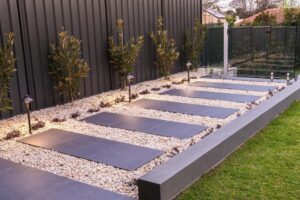The fundamentals of landscape design can be broken down into nine key principles and strategies. The first principle is that you must create an overall conceptual focus, which will make the entire property easier to read. By organizing your space and ensuring that all elements complement each other, you will increase its comfort and familiarity. Next, you must consider how you plan to use the space and the destination you wish to achieve. Keeping these three factors in mind will create the perfect landscape.
 To create a beautiful landscape, you should be concerned with the balance between colour and shape. While too much variety can be overwhelming, a flat landscape will be aesthetically pleasing. To achieve the ideal balance between colours, you can choose symmetrical or asymmetrical designs. In either case, you will need to balance out the number of points of interest in the landscape, ensuring that the area is not too crowded and feels well-balanced.
To create a beautiful landscape, you should be concerned with the balance between colour and shape. While too much variety can be overwhelming, a flat landscape will be aesthetically pleasing. To achieve the ideal balance between colours, you can choose symmetrical or asymmetrical designs. In either case, you will need to balance out the number of points of interest in the landscape, ensuring that the area is not too crowded and feels well-balanced.
There are a lot of ways to create a green and beautiful landscape. You should also consider the size of the plants that will be planted in your garden. The mature size of the plants will depend on the conditions that the plants are grown in. In order to avoid creating an overly large garden, try to grow smaller and more efficient plants. You can also choose a sustainable landscape design by using environmentally-friendly hardscapes and resources. A few of the most common techniques are described below.
Another key principle in Outscape-Constructions landscape design Adelaide is unity and proportion. These principles refer to the ratios between individual components and groups of them. If a landscape has too many of these, it will look overcrowded and uncomfortable. Instead, it should be balanced between colour and shape. The transitions between different elements should be smooth and seamless. Otherwise, the design will appear abruptly and be difficult to read. When planning a landscape, keep in mind that balance is the most important principle.
Choosing a colour scheme is crucial to the overall look of your yard. You should consider the type of light the plants will receive when they are in direct sunlight. A colour that is too intense or too dull will look disorienting. The opposite is true for colours that are in direct sunlight. You should consider the time of day you use your yard and whether the sun will be in your backyard. A few simple rules will help you choose the best landscape design for your home.
The second rule is the principle of proportion. This rule explains the differences in the size of individual components and groups. You should also consider the shape of your lot, as this will affect the shape of your hardscape. While the shape of your lot is important, you should keep in mind the shape of your house. The shape of the house will affect the shapes and sizes of your hardscape. Moreover, the style of the home and the landscape should blend with the home.
The third principle is pacing. You should have pacing in your landscape design. The pacing will lead people through the space. The scale of the elements will also affect the flow of the space. In addition to the scale, it’s also important to consider the type of plants that you use. You can have colourful grasses or flowery shrubs that will grow in your yard. A pond will be a great way to create a focal point in your landscape.
Lastly, you need to consider the colour of your plants and other components. In a landscape, colours are very important to the design. You must keep in mind that they complement each other and should not clash with each other. You should choose neutral colours for your grass lawns and other plants. Alternatively, you should choose a colour that accentuates the shape of your grassy area. It should be a shade that complements the colour of the surrounding plants and rocks.